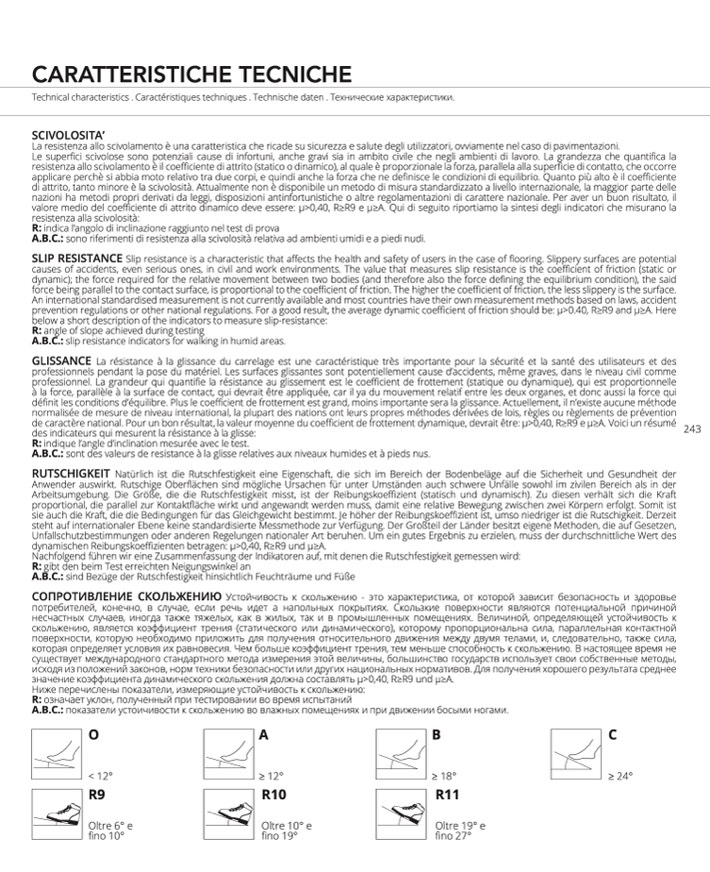
CARATTERISTICHE TECNICHE
Technical characteristics . Caractéristiques techniques . Technische daten . Texнические характеристики.
SCIVOLOSITA’
La resistenza allo scivolamento è una caratteristica che ricade su sicurezza e salute degli utilizzatori, ovviamente nel caso di pavimentazioni.
Le superfici scivolose sono potenziali cause di infortuni, anche gravi sia in ambito civile che negli ambienti di lavoro. La grandezza che quanti
fica la
resistenza allo scivolamento è il coefficiente di attrito (statico o dinamico), al quale è proporzionale la forza, parallela alla superficie di contatto, che occorre
applicare perchè si abbia moto relativo tra due corpi, e quindi anche la forza che ne definisce le condizioni di equilibrio. Quanto più alto è il coefficiente
di attrito, tanto minore è la scivolosità. Attualmente non è disponibile un metodo di misura standardizzato a livello internazionale, la maggior parte delle
nazioni ha metodi propri derivati da leggi, disposizioni antinfortunistiche o altre regolamentazioni di carattere nazionale. Per aver un buon risultato, il
valore medio del coefficiente di attrito dinamico deve essere: μ>0,40, R≥R9 e μ≥A. Qui di seguito riportiamo la sintesi degli indicatori che misurano la
resistenza alla scivolosità:
R: indica l’angolo di inclinazione raggiunto nel test di prova
A.B.C.: sono riferimenti di resistenza alla scivolosità relativa ad ambienti umidi e a piedi nudi.
SLIP RESISTANCE Slip resistance is a characteristic that affects the health and safety of users in the case of flooring. Slippery surfaces are potential
causes of accidents, even serious ones, in civil and work environments. The value that measures slip resistance is the coefficient of friction (static or
dynamic); the force required for the relative movement between two bodies (and therefore also the force defining the equilibrium condition), the said
force being parallel to the contact surface, is proportional to the coefficient of friction. The higher the coefficient of friction, the less slippery is the surface.
An international standardised measurement is not currently available and most countries have their own measurement methods based on laws, accident
prevention regulations or other national regulations. For a good result, the average dynamic coefficient of friction should be: μ>0.40, R≥R9 and μ≥A. Here
below a short description of the indicators to measure slip-resistance:
R: angle of slope achieved during testing
A.B.C.: slip resistance indicators for walking in humid areas.
GLISSANCE La résistance à la glissance du carrelage est une caractéristique très importante pour la sécurité et la santé des utilisateurs et des
professionnels pendant la pose du matériel. Les surfaces glissantes sont potentiellement cause d’accidents, même graves, dans le niveau civil comme
professionnel. La grandeur qui quantifie la résistance au glissement est le coefficient de frottement (statique ou dynamique), qui est proportionnelle
à la force, parallèle
à la surface de contact, qui devrait
être appliquée, car il ya du mouvement relatif entre les deux organes, et donc aussi la force qui
définit les conditions d’
équilibre. Plus le coefficient de frottement est grand, moins importante sera la glissance. Actuellement, il n’existe aucune méthode
normalisée de mesure de niveau international, la plupart des nations ont leurs propres méthodes dérivées de lois, règles ou règlements de pr
évention
de caractère national. Pour un bon résultat, la valeur moyenne du coefficient de frottement dynamique, devrait être: μ>0,40, R≥R9 e μ≥A. Voici un résumé
243
des indicateurs qui mesurent la résistance à la glisse:
RUTSCHIGKEIT Natürlich ist die Rutschfestigkeit eine Eigenschaft, die sich im Bereich der Bodenbel
äge auf die Sicherheit und Gesundheit der
Anwender auswirkt. Rutschige Oberflächen sind mögliche Ursachen f
ür unter Umständen auch schwere Unfälle sowohl im zivilen Bereich als in der
Arbeitsumgebung. Die Größe, die die Rutschfestigkeit misst, ist der Reibungskoeffizient (statisch und dynamisch). Zu diesen verhält sich die Kraft
proportional, die parallel zur Kontaktfläche wirkt und angewandt werden muss, damit eine relative Bewegung zwischen zwei Körpern erfolgt. Somit ist
sie auch die Kraft, die die Bedingungen für das Gleichgewicht bestimmt. Je höher der Reibungskoeffizient ist, umso niedriger ist die Rutschigkeit. Derzeit
steht auf internationaler Ebene keine standardisierte Messmethode zur Verfügung. Der Großteil der Länder besitzt eigene Methoden, die auf Gesetzen,
Unfallschutzbestimmungen oder anderen Regelungen nationaler Art beruhen. Um ein gutes Ergebnis zu erzielen, muss der durchschnittliche Wert des
dynamischen Reibungskoeffizienten betragen: μ>0,40, R≥R9 und μ≥A.
Nachfolgend führen wir eine Zusammenfassung der Indikatoren auf, mit denen die Rutschfestigkeit gemessen wird:
R: gibt den beim Test erreichten Neigungswinkel an
A.B.C.: sind Bezüge der Rutschfestigkeit hinsichtlich Feuchträume und Füße
СОПРОТИВЛЕНИЕ СКОЛЬЖЕНИЮ Устойчивость к скольжению - это характеристика, от которой зависит безопасность и здоровье
потребителей, конечнo, в случае, если речь идет а напольных покрытиях. Скользкие поверхности являются потенциально
й причиной
несчастных случаев, иногда также тяжелых, как в жилых, так и в промышленных помещениях. Величиной, определяющей устойчивость к
скольжению, является коэффициент трения (статического или динамического), которому пропорциональна сила, параллельная контактной
поверхности, которую необходимо приложить для получения относительного движения между двумя телами, и, следовательно, также сила,
которая определяет условия их равновесия. Чем больше коэффициент трения, тем меньше способность к скольжению. В настоящее время не
существует международного стандартного метода измерения этой величины, большинство государств использует свои собственные методы,
исходя из положений законов, норм техники безопасности или других национальных нормативов. Для получения хорошего результата среднее
значение коэффициента динамического скольжения должна составлять μ>0,40, R≥R9 und μ≥A.
Ниже перечислены показатели, измеряющие устойчивость к скольжению:
R: означает уклон, полученный при тестировании во время испытани
й
А.В.С.: показатели устоичивости к скольжению во влажных помещениях и при движении босыми ногами.
O
A
B
C
R: indique l’angle d’inclination mesurée avec le test.
A.B.C.: sont des valeurs de resistance à la glisse relatives aux niveaux humides et
à pieds nus.
< 12°
R9
Oltre 6° e
fino 10°
≥ 12°
R10
Oltre 10° e
fino 19°
≥ 18°
≥ 24°
R11
Oltre 19° e
fino 27°

